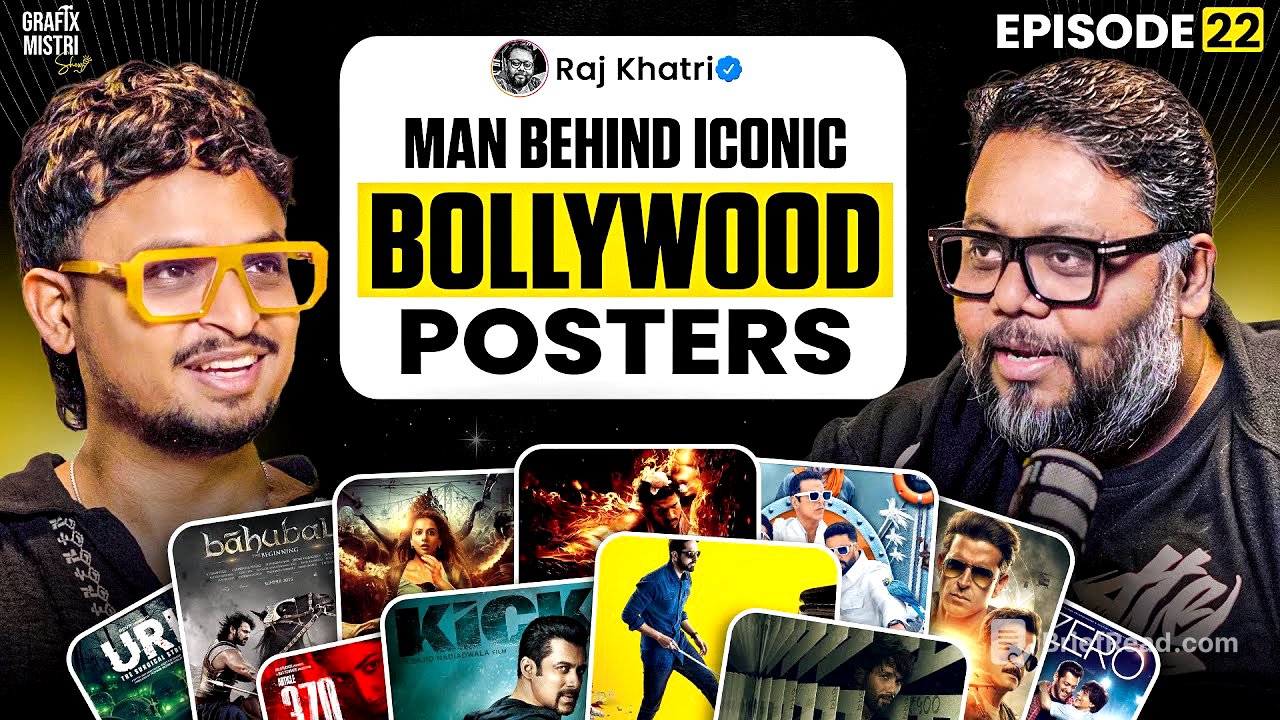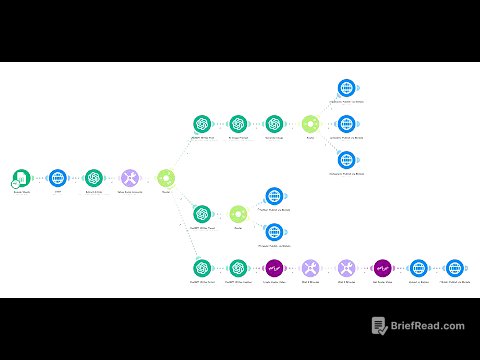TLDR;
This YouTube video features an interview with a seasoned movie poster designer, Raj Khatri, who shares insights about his journey, the industry, and the impact of AI on design. He emphasizes the importance of storytelling, continuous learning, and maintaining originality in a world increasingly influenced by technology. Khatri also touches on the challenges of plagiarism, the creative process behind poster design, and the balance between artistic vision and client requirements.
- The movie poster industry is a peripheral for a movie industry.
- AI is a companion, not a competition.
- The human mind is a mix of many things, AI is a what you are feeding it.
- The bigger the film, the simpler the title.
Intro [0:00]
Raj Khatri, a poster designer with over 200 films and 500+ posters, discusses his journey and the current state of movie poster design. He aims to connect with new graphic designers, sharing insights into an art form that is a powerful storytelling medium and the oldest medium in the world. The podcast intends to shed light on the industry's workings, which are often misunderstood, especially regarding the role of designers versus film production houses.
Early Career and Poster Junkie [1:55]
Khatri expresses reluctance towards media appearances but acknowledges the need to connect with aspiring designers. He created an Instagram page called "Poster Junkie" during the COVID-19 pandemic to share his thoughts on art and creativity. The page organically grew to 21,000 followers, and he hired team members from across India through it. He emphasizes the importance of reaching out to new talent and highlighting movie posters as a serious art form and career.
The Importance of Movie Posters [5:51]
Movie posters are the oldest storytelling medium, essential for creating the first impression and excitement for a film. They can significantly influence a film's perception, either positively or negatively. Motion posters and trailers also play a crucial role in building this perception. Khatri aims to encourage new designers to take this art form seriously, as it is often overlooked in design education.
Industry Insights and Perceptions [7:34]
Khatri addresses the common misconception that film production houses create movie posters. He clarifies that specialized designers handle this task, similar to how ad campaigns are created by specialized agencies. The movie poster industry thrives in cities with active film industries like Chennai, Hyderabad, and Mumbai. He emphasizes that cinema and cricket are enduring aspects of Indian culture, providing lasting opportunities for those in storytelling.
Concept vs. Star Power [9:10]
Khatri explains that some films require a strong concept, while others rely on star power. He views each movie poster as his film, where he acts as the director, distilling a three-hour movie into a single frame. While trends change, he advises against blindly following them, advocating for creating something original. He uses the example of A.R. Rahman, who often creates music that defies trends yet becomes a hit.
AI and the Future of Design [10:50]
Khatri addresses the fear surrounding AI in the design industry, cautioning against the herd mentality of replicating popular AI effects. He argues that unique ideas and human creativity will always be valuable. AI is a tool, and the human brain remains essential for delivering end-to-end products. He views AI as a companion, not a competitor, and emphasizes that it enhances productivity rather than replacing human intellect.
AI as a Tool, Not a Replacement [12:27]
Khatri compares AI to the printing press, which was initially feared but ultimately led to increased knowledge transfer. AI will accelerate production, allowing designers to offer more options to clients. He stresses that original thoughts and inner creativity are essential to avoid being threatened by AI. AI is a sophisticated tool that aids in concept building and asset creation, but the human interface remains crucial.
The Lack of Focus on Movie Posters [15:26]
Khatri observes that the design industry lacks discussion about movie posters, despite the vast scope and importance of this art form. He notes that movies are constantly talked about and criticized, but the design aspect is often ignored. He attributes this to the plagiarism prevalent in Indian movie posters since the digital era, which has led to a lack of respect for the industry.
Plagiarism and Creative Responsibility [16:29]
Khatri discusses the issue of plagiarism in Bollywood movie posters, emphasizing that it is an easy target for criticism. He believes that those in the art industry should analyze and learn before making accusations. He shares personal experiences of having his posters compared to similar works, highlighting that human anatomy and common themes can lead to unintentional similarities. He stresses that many factors are beyond a designer's control, and larger films involve numerous stakeholders.
The Subconscious Mind and Creative Overlap [18:34]
Khatri argues that in mainstream creative work with high output demands, concept overlapping is inevitable. Everything is a derivative of a derivative, and the subconscious mind absorbs visual pollution, leading to unintentional similarities. He emphasizes that the key is how one combines and transforms existing elements to create something new.
Movie Posters as an Inclusive Art Form [19:10]
Khatri believes that movie posters are an inclusive art form that encompasses photography, typography, illustration, 3D art, and photo manipulation. He has explored all these elements in his career. Each movie presents a new challenge, requiring designers to discover new languages and find unique elements. He appreciates the global work in Hollywood, Japan, China, and Europe, finding excitement in seeing good work being done worldwide.
Gatekeepers and Artistic Integrity [20:48]
Khatri avoids comparing Bollywood posters unfavorably to others, stating that the responsibility lies with the gatekeepers who approve the work. He believes that true artists never insult other artists and that every movie has its own style and story. The internet is a battleground where people often seek to prove their point, and artists should avoid participating in unnecessary criticism.
AI-Generated Posters and Skill Development [22:11]
Khatri recounts an incident where an AI-generated poster similar to his work for "Bade Miyan Chote Miyan" was posted online, leading to accusations of plagiarism. He emphasizes the importance of analysis and learning before criticizing. He advises young designers to focus on developing their skills rather than chasing fame, as skills will naturally lead to recognition and success.
The Importance of Originality [23:48]
Khatri reiterates the importance of being true to one's craft and focusing on originality. He criticizes the trend of seeking shortcuts and fame, emphasizing that genuine creativity and skill development are more valuable. He advises against superficial analysis and encourages young designers to first establish themselves in their field before critiquing others.
Reaction Videos and Podcast Hype [25:07]
Khatri expresses his lack of understanding for reaction videos, viewing them as a scam. He notes that much of the youth engaging with such content are from India, making it a powerful force on the internet. He also discusses the hype around podcasts, viewing them as a modern form of interviews and audiobooks. He enjoys listening to podcasts, particularly those that explore the human mind and personal journeys.
Early Influences and Boarding School [28:32]
Khatri shares his journey from childhood, starting with his time in boarding school in Khandala. He describes boarding school as a small world with its own rules, discipline, and politics. He was academically strong and skilled in sketching and illustration, often creating chart papers and participating in drawing competitions.
Movie Posters and Early Fascination [29:40]
Khatri recounts his early fascination with movie posters, particularly during visits to video libraries in the 80s and early 90s. He would spend hours observing the posters on video cassettes. He also enjoyed watching "Chitrahaar" on Doordarshan, where he would get excited seeing posters of new films. He would cut out theatre listings from newspapers and collect audio cassette covers, recreating them in his own style.
Rock Music and Science [32:32]
Khatri's interest in Western and rock music influenced his artistic sensibilities. He collected album covers and was fascinated by the art form and thematic elements of rock bands. Despite his artistic inclinations, he pursued science in 11th and 12th grade, which led to a loss of interest in studies.
College Struggles and a Turning Point [34:10]
Khatri describes his college years as a boring and dry period. He scored poorly in his 12th-grade exams, preventing him from joining J.J. College of Art. He enrolled in B.Sc. but lost a year due to KT (Keep Term), leading his father to question his path. He then joined an institute promising training in Jurassic Park-level graphics, which he now views with amusement.
Family Tragedy and Career Shift [37:30]
In 2002, Khatri's father passed away, prompting him to leave B.Sc. and focus on earning to support his family. He started working at a small place, doing illustration and interface design. During this time, he remained fond of movie posters and sought to learn more about the industry.
Building a Computer and Learning Design [39:11]
Khatri built a computer through "jugaad" (improvisation), using old parts from friends. He worked in a cassette library for ₹1500, where he collected promotional posters. He used chip magazines with free software to watch movies and create a library of images. He then made his own versions of movie posters, experimenting with Photoshop and learning design techniques.
Joining Epigram and Entering the Industry [43:22]
In 2004, Khatri sought to align his career with his passion for movies. He reached out to a company that designed websites for films and was hired. He discovered that the company also had a movie poster division called Epigram. He met Nabil, who recognized his interest and knowledge of movies, and joined Epigram on January 3, 2005.
Early Days at Epigram and Creative Frustrations [45:58]
Khatri's first campaign was for the movie "Swades." He initially worked on basic tasks but felt that the work lacked originality. He recalls a horror film called "Naina" where he created a unique poster that was approved, marking a turning point in his career. He then made web banners and shared photos of his work with friends, marking his entry into the movie poster industry.
Meeting Influential Figures and Salary [47:59]
Khatri recounts meeting Ashutosh Gowariker and other influential figures while working at Epigram. He met Amitabh Bachchan through Ram Gopal Varma. His first salary was ₹11,000, a significant increase from his previous earnings. He worked on films like "Jodha Akbar" and "Shootout at Lokhandwala."
Leaving Epigram and Joining Marching Ants [52:01]
After four years at Epigram, Khatri felt he had become the best in the agency but was no longer learning or challenged. In 2009, he left Epigram and joined Marching Ants, an agency that was changing the game of movie posters in India. He was fascinated by their Hollywood-standard work and got a call for an interview after sending them his work.
Joining Marching Ants and Current Role [53:48]
Khatri joined Marching Ants in 2009 and has been there for 17 years. He leads Marching Ants as a creative director. He worked on a concept for an RGB film by Mr. Bachchan as his interview task. Marching Ants is known as a game-changing agency in the Indian movie poster industry, with a portfolio of memorable posters.
Scope and Passion [56:32]
Khatri emphasizes that scope is within oneself, not in the field. He encourages aspiring designers to strive to do something new and exciting, as this will automatically create opportunities. He shares his journey of self-learning and the challenges he faced due to limited resources.
Connecting with Talent and Team Building [57:36]
Khatri connected with talent through his "Poster Junkie" page and hired team members from across India. He has a test for potential hires to assess their capabilities and understanding of design. He emphasizes the importance of exposure and mentorship for aspiring designers.
The Creative Process and Film Campaigns [58:20]
Khatri explains that film campaigns start with creating a concept, followed by a specialized shoot. He emphasizes the importance of having a clear concept before the photoshoot. If a shoot cannot be done, the team uses a continuity library of images from the film. In the most difficult scenario, they take screenshots from the film to create posters.
Illustration and Movie Posters [1:03:06]
Khatri notes that illustration-related posters are often perceived as niche or art films, which can be a problem for mainstream movies. He shares that feedback has indicated that illustrated posters may not resonate with a broad audience.
Client Interaction and Deliverables [1:03:56]
Khatri explains that big films rarely go to freelancers due to the risk of leaks and the need for NDAs. Freelancers also cannot handle the deliverables required for large projects. He uses the example of the movie "Andhadhun" to illustrate the process, starting with a brief that can be a four-page story or a one-page synopsis.
The Creative Process and Feedback [1:07:31]
Khatri shares that after confirmation, the agency receives a full bound script. He prefers someone on his team to read it and provide an audio narration. He emphasizes that he does not use Chat GPT for movie data. The team then has a brief call to ask questions. In extreme cases, the film is available to watch.
Dos and Don'ts [1:09:18]
Khatri explains that there are many restrictions in film campaigns, including what can and cannot be revealed. He emphasizes that it is tough to work within these parameters. He notes that it is easiest to sit and criticize, but it is not easy to create within the given constraints.
Unique vs. Generic [1:10:45]
Khatri explains that unique means being different from all others and not catering to everyone. The wider you open it, the more generic it becomes. He emphasizes that it is challenging to do something new with generic content.
The Approval Process [1:11:43]
Khatri shares that the drafted campaign goes to the marketing team, then to producers, directors, and actors. There are many rounds of feedback, and everyone has their own reservations. The team then makes sketches and combos, followed by rounds of approval and changes.
The Finishing Process [1:12:37]
Khatri explains that the finishing process involves image selection, rough drafts, and multiple rounds of feedback. The team then does the first round of finishing, followed by more feedback and revisions. The process culminates in art working, where everything is done in high resolution for printing and coding.
Campaign Scale and Freelancing [1:14:07]
Khatri does not disclose the monetary scale of campaigns, as he is employed by an agency. He notes that freelancers typically work on OTT shows, while big films go to agencies. He emphasizes that the agency has a complete team to handle the volatile nature of film releases.
Limitations and Sensitivities [1:15:47]
Khatri shares that there are many complications in the industry, including limitations in certain countries and the need to accommodate last-minute changes. He emphasizes that India is a sensitive country, and everything must be legally clear.
Key Art vs. Poster [1:17:44]
Khatri explains that "key art" is the main art of a film, while "poster" is a generic term. He then transitions into a live exercise to demonstrate his thought process.
Live Exercise: Pitching a Movie Poster [1:18:54]
Khatri engages in a live exercise, pitching ideas for a movie poster based on a brief about a family drama. He explores different pitches, including comedy, emotional, and family drama, and discusses how the language changes based on the pitch.
Color Psychology and Typography [1:21:27]
Khatri discusses the importance of color psychology and typography in movie posters. He explains how different colors evoke different emotions and how typography can enhance the visual message. He shares a simple rule: if the poster is busy, the title should be simple, and vice versa.
Hollywood vs. Regional Cinema [1:23:12]
Khatri notes that the bigger the film in Hollywood, the simpler the title. He contrasts this with regional cinema, where posters often have more loudness and try to tell a lot of the story in the title. He explains that the language of the creative determines the type of typography used.
Poster Statistics and Artistic Life [1:25:16]
Khatri shares that he has made posters for over 200 films and released over 500 key arts. He emphasizes the importance of preserving one's work and continuously trying to improve. He acknowledges that an artistic life can be difficult and that things rarely go as planned.
Maintaining Originality and Creative Balance [1:26:21]
Khatri stresses the importance of reinvestigating ideas and reconnecting with the core purpose of one's work. He shares that he has realized that there are not many clients who fully understand his vision, but he tries to balance their requirements with his artistic approach.
Timeline and Creative Control [1:28:37]
Khatri explains that a film campaign can last from three to six months, and some can even last for years. He shares that he was part of the first "Baahubali" film but not the second, as the team likely wanted more control.
AI and Creative Consistency [1:31:07]
Khatri believes that AI has limitations in bringing creative consistency and generating unique ideas. He views AI as a cheap replacement for CGI and stock images, useful for asset creation but not for final output.
The Future of Design and AI [1:32:47]
Khatri predicts that AI will continue to improve, with tools like Photoshop's harmonize feature becoming more prevalent. He believes that middle-level skills will decrease, but unique ideas will remain key. He emphasizes that the human mind is a mix of many things, while AI mimics a set of infections.
AI as a Companion and the Human Element [1:34:46]
Khatri views AI as a companion, not a competition, and emphasizes that it is a secondary brain. He cautions against blindly following AI trends and stresses the importance of using it smartly. He believes that AI will become a norm, similar to Photoshop, but the human element will remain essential.
The Impact of AI on Future Generations [1:36:30]
Khatri expresses concern that AI may kill the desire to draw in future generations, as children may rely on AI to create art instead of developing their own skills. He notes that his son, who is growing up with technology, may not even understand the concept of drawing by hand.
The Transition from Analog to Digital [1:37:57]
Khatri reflects on his generation's transition from analog to digital, emphasizing the importance of encouraging human work and creativity. He shares his thoughts on recent controversies surrounding Bollywood posters and the tendency to criticize them.
Bollywood Posters and Creative Norms [1:38:56]
Khatri discusses the recent controversy surrounding similar Bollywood posters, explaining that there are only a few ways to show romance. He notes that these are template works and that there are many similar posters in Hollywood. He emphasizes that Bollywood is an easy target for criticism.
The Indian Mentality and Creative Freedom [1:40:12]
Khatri reflects on the Indian mentality, noting that there is often a problem with those who are above us. He shares that he used to be critical of copied posters but has since understood the complexities involved. He emphasizes that commercial art requires working within parameters.
Heropanti 2 and Homage vs. Copy [1:41:11]
Khatri recounts an incident where he was trolled for a "Heropanti 2" poster that was accused of copying John Wick. He explains that the poster was a homage to an old stunt film and that those who criticized it lacked knowledge of the history.
Star-Centric vs. Concept-Driven Posters [1:44:00]
Khatri explains that posters for big stars are often star-centric due to fan expectations and the need to keep it generic. He contrasts this with concept-driven films like "Andhadhun," where the story takes precedence.
Deliverables and Campaign Elements [1:47:50]
Khatri outlines the deliverables of a film campaign, including trailers, promos, print campaigns, digital campaigns, and on-ground activities. He notes that the agency is responsible for creating hype and longevity for the film.
Poster Numbers and OTT Platforms [1:49:15]
Khatri shares that a big film like "Fighter" may have six to seven posters, while smaller films have three to four. He notes that OTT platforms often require more face-driven posters due to their reliance on research numbers.
Software Tools and Photoshop [1:51:08]
Khatri shares that he uses Illustrator and Photoshop, emphasizing that Photoshop has to be in one's blood. He has been using Photoshop since version 4.5 and is always curious about new features.
Piracy and Subscription Models [1:53:02]
Khatri discusses the issue of piracy in India, noting that people often expect to get things for free. He encourages aspiring designers to subscribe to software and support the industry.
The Importance of Continuous Learning [1:53:30]
Khatri emphasizes the importance of continuous learning and practice. He shares that he still works on the final finish of posters himself and compares his work to previous years. He advises against seeking quick fame and position, emphasizing that love for the craft is essential.
Legacy and Personal Work [1:57:47]
Khatri shares that he is at the peak of his career and wants to use his remaining years to create meaningful work. He emphasizes the importance of legacy and doing personal work. He is currently learning 3D and cinema 4D.
Agency Ownership and Creative Control [1:59:22]
Khatri explains that he prefers working at an agency because it allows him to focus on the creative aspect without the responsibilities of ownership. He states that he wants to reach a stage where he does not depend on his work for his livelihood and can do curated work.
Artistic Fulfillment vs. Wealth [1:59:56]
Khatri states that one must choose between dying as an artist or rich, as it is impossible to be both. He emphasizes the importance of learning and growing, and his goal is to have his basic life sorted so he can do curated work.
Favorite Posters and Artists [2:03:13]
Khatri shares his favorite posters and artists, including Druce Trujan, Roger Castle, and Robert Magennis. He emphasizes the importance of understanding how an artist thinks and finding their trail.
Indian Artists and Contemporary Influences [2:05:40]
Khatri shares his favorite Indian posters, including "Kala Patthar" and "Rustom." He also mentions contemporary artists like Shiva, John by Tuning, and Gopi Prasanna. He emphasizes the importance of pushing the envelope and doing good work with big films.
Relevance and Mainstream Success [2:08:41]
Khatri emphasizes that good work with big films matters more because it reaches more people and gains more recognition. He notes that freelancers may get work, but it may not be as relevant.
The Journey and Rejected Ideas [2:09:41]
Khatri emphasizes that it is not just about the final poster but also the journey behind it. He encourages aspiring designers to be consistent and bear the challenges.
Next Steps and Saturation [2:10:44]
Khatri shares that he is not the smartest in the room and is always learning. He wants to learn from others and continue to grow. He acknowledges that he reached a saturation point in his previous agency and wants to do his own thing at some point.
Agency Ownership and Creative Focus [2:12:24]
Khatri explains that he does not want to own an agency because it would distract him from his creative focus. He prefers to focus on the creative aspect and leave the business responsibilities to others.
Artistic Legacy and Future Goals [2:13:37]
Khatri states that he wants to die as an artist and that he is focused on creating a legacy of good work. He emphasizes the importance of doing personal work and continuously striving for improvement.
Sayara Posters and Closing Remarks [2:14:17]
Khatri shares that the posters for "Sayara" were made by a close friend and that they were decent within the limitations of the structure. He emphasizes that everything can be better and that the purpose is to make people come to the theatre.









